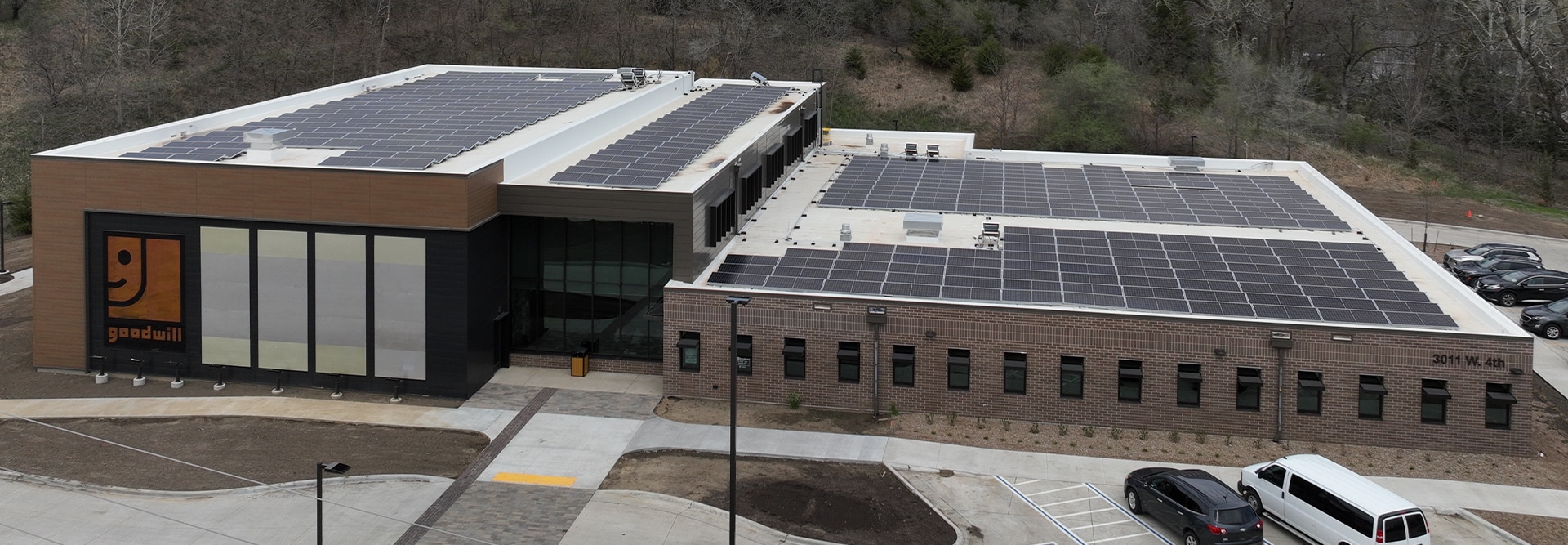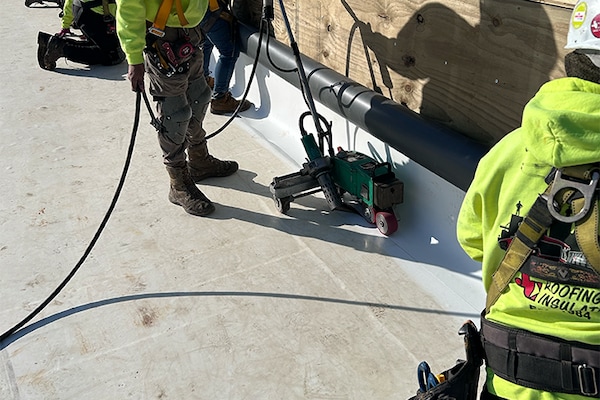
System Type
TPO
Building Vertical
Mixed Use
Size
300 squares
Completed
March 2025
About Goodwill of the Great Plains
Goodwill of the Great Plains, based in Sioux City, IA, serves northwest Iowa, northeast Nebraska, southwest Minnesota and all of South Dakota. They operate 22 retail stores and donation centers, two online stores and an Outlet Center. They also operate mission programming through various services, programs and special events throughout their territory.
What many people don’t realize is that their headquarters in Sioux City is also classified as an adult daycare center — a facility that offers integrated day services and day habilitation for people with cognitive and physical disabilities, from dementia and Alzheimer's to physical disabilities including, in some cases, the need for full mobility chairs. The existing headquarters building dated back to the 1970s, and was no longer suited to serve the needs of Goodwill’s clients in size, accessibility demands, energy efficiency, or weather resistance.
In response to these needs, GAF PlatinumElite™ Contractor JC Roofing and Insulating of Siouxland, CMBA Architects, and GAF set out to develop a groundbreaking, net-zero energy, and accessible building for the Goodwill of the Great Plains in Sioux City, Iowa. The facility, opened in March 2025, now accommodates the integrated day services, life skills programs, and day-habilitation programs for those with physical and cognitive disabilities in the greater Siouxland area.
Challenges
Net-Zero goal — The building’s project partners were determined to honor the Goodwill of the Great Plains organization’s deep commitment to sustainability, and set out to create a net-zero energy building*. Among the decisions supporting the goal, the design team integrated solar panels throughout the building, which will allow it to produce as much energy as it consumes annually. The building also uses a geothermal system with over 60 wells. Reflective features incorporated into the building design — such as white reflective TPO on the roof — will help minimize heat absorption as the TPO reflects solar energy away from the building, helping to lower the building’s overall energy consumption and cooling costs.
Accessibility — The entire design of the building incorporated inclusive design standards chosen to exceed code requirements and truly, creatively, address quality of life issues for the occupants.
Coordination — Continuous collaboration, communication, and adaptability were crucial to address on-site challenges and effectively meet the building's accessibility and sustainability needs. For example, the original plan called for mechanically attaching the insulation layers. Upon review, JC Roofing recommended using GAF LRF Foam adhesive, eliminating approximately 30,000 screws that would have penetrated the decking. Adapting the plan significantly improves the roofing assembly’s thermal performance.
Solution
EverGuard® SA TPO Self-Adhered Roof Membrane provided ease of installation along with reflectivity to help “reduce strain on the building's HVAC systems, potentially saving both energy and equipment maintenance costs” said Eric Coleman, Project Architect at CMBA Architects.
The team momentarily considered cutting costs by eliminating HD cover board from the project, but foresight convinced them to include a layer of GAF EnergyGuard™ HD Polyiso Cover Board. "With solar panels covering 90% of the building, the HD ISO layer beneath the 60 mil membrane is essential for supporting the added weight and ensuring long-term performance," said Gregg Wilson, Project Manager at JC Roofing and Insulating.
Finally, beneath two layers of EnergyGuard™ Polyiso Insulation, GAF SA Vapor Retarder XL was applied directly to the metal deck. "The SA Vapor Retarder XL is a game-changer for roofing projects,” said John Cain, founder of JC Roofing and Insulating. “Its impressive thickness and tackiness provides superior sealing around penetrations like screw holes, while its user-friendly application process—just peel, stick, roll — offers substantial labor savings.”
“This roofing solution lessens the strain on the building's HVAC systems, potentially saving both energy and equipment maintenance costs” shares Eric Coleman, Project Architect, at CMBA Architects. “By designing a net-zero energy building with innovative features like integrated solar panels and a high-performance building enclosure that includes reflective roofing, we're not only reducing our annual energy use but also demonstrating that sustainability and social impact can go hand in hand.”
* Net-zero certification decision expected in 2026
Project images
Download as PDF
Download
About JC Roofing and Insulating
Related projects

Stanley Center for Peace and Security
TPO

The Revington
TPO

